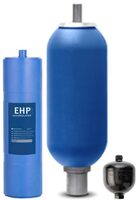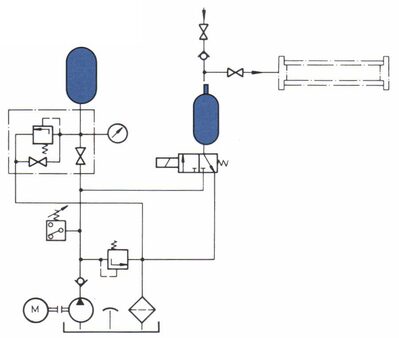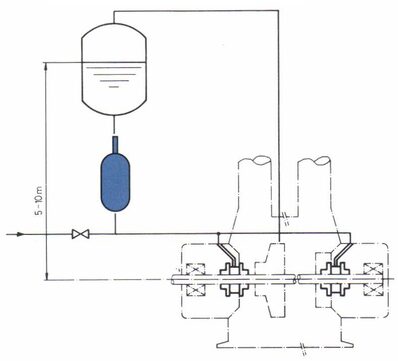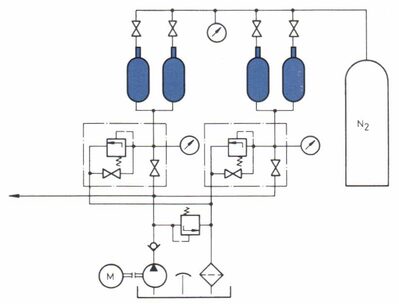Hydraulic accumulators - Pressure increasing

GENERALITY
The common gas cylinders on the market are generally supplied at a pressure of 200 bar, which many times is not sufficient, for example, for accumulator preloads. With the use of a hydraulic power unit and a Transfer accumulator it is possible to create a simple equipment to increase the pressure. The Hydraulic accumulator is filled with gas from the cylinder and is compressed from the side of the bag with pressurized oil until the flow valve closes. This valve controls a stroke end which releases the oil pressure and thus allows the gas to flow again from the cylinder. This cycle can be repeated until the desired final gas pressure is reached.

PRESSURE TEST
The pressure tests (high pressure pipes) are carried out in most cases with water in order to avoid, in case of breakage of a piece under test, oil leaking or splashing from the test bench. To avoid having to manufacture the entire stainless steel control unit, a normal hydraulic unit is used with the addition of a Transfer accumulator. A standard Hydraulic accumulator is also required in order to maintain the pressure, thus avoiding that the pump is always running.

LIQUIDS SEPARATION
Rotating gaskets are used in many industrial compressors. These gaskets require a special liquid whose pressure must be 0.5-1 bar higher than that of the gas that reigns in the compressor. For reasons of operation and pollution, in compressor applications in petrochemical plants, compressed gas must absolutely not mix with the above described special liquid. A tank that must be 5 to 10 meters above the level at which the rotary seals are located is filled with a neutral liquid and pressurized with the gas pressure of the compressor. In addition to this tank, a Transfer accumulator is installed which guarantees the absolute separation between the liquids. Likewise, the same application can be found in the sealing of boilers in the chemical industry.

GREATER ACCUMULATION CAPACITY
In many hydraulic systems only small differences in pressure are required in many cases (eg die-casting machines), or large quantities of oil must be stored (eg rolling mills). In both cases large volumes of gas are required. The cost of the system can be considerably reduced with the application of Transfer accumulators combined with additional gas cylinders
The hydraulic accumulators is an essential component for the optimum operation of a hydrauliccircuit. In hydraulic circuits, theaccumulator enables:
Energy Storage: saves energy withoutloss and redistributes when required therefore reducing installed power.
Pressure compensation: absorbs pressure spikesfrom pumps or other components to control pressure and flow-rates in ahydraulic circuit.
VolumeControl: absorbs fluid volume variations induced by temperaturechanges in a closed hydraulic circuit and maintains a rated pressure.
MaintainsFluid Flow Rate: an accumulator can maintain the fluid flowrate in case of pump failure and can also be used as a mobile fluid reserveunder pressure.
Emergency EnergyStorage: in case of failure of the main energy source, an accumulator canprovide sufficient energy to complete an operation or to realize a fullhydraulic cycle.
Preventsmixing of fluids: Transfer of energy from a fluid to anotherfluid without any risk of mixing.
Shock absorber: suppresses shocks andvibrations in hydraulic systems of lifting vehicles (e.g. Forklift trucks) andmaintains real suspension of the load on a gas spring.

COMER ACCUMULATOR SERVICE CENTER
From 2019 COMER is officially the Parker / olaer Accumulators service center. Comer has all the appropriate equipment and large spare parts warehouse to perform checks on the preloads, internal bag replacements and interventions in general on the whole range of accumulators in production both Parker and Olaer.
 Download type EHV/EHVF >>
Download type EHV/EHVF >>